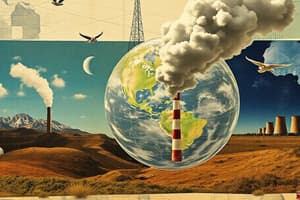Podcast
Questions and Answers
Which gas is present in both the early atmosphere and today's atmosphere?
Which gas is present in both the early atmosphere and today's atmosphere?
- Oxygen
- Nitrogen (correct)
- Sulfur
- Carbon dioxide (correct)
Today's atmosphere contains more sulfur than the early atmosphere.
Today's atmosphere contains more sulfur than the early atmosphere.
False (B)
Name one gas that was present in the early atmosphere but is not present in today's atmosphere.
Name one gas that was present in the early atmosphere but is not present in today's atmosphere.
Sulfur
In the early atmosphere, there was a significant amount of ________ vapor.
In the early atmosphere, there was a significant amount of ________ vapor.
Match the following gases to whether they were present in the early atmosphere or today's atmosphere:
Match the following gases to whether they were present in the early atmosphere or today's atmosphere:
What was a significant component released by volcanoes that contributed to the formation of the early atmosphere?
What was a significant component released by volcanoes that contributed to the formation of the early atmosphere?
Liquid water is not essential for life.
Liquid water is not essential for life.
What process increased the amount of oxygen in the atmosphere from 3,000 million years ago?
What process increased the amount of oxygen in the atmosphere from 3,000 million years ago?
The formation of _____ was a key event that occurred when water vapor cooled and condensed.
The formation of _____ was a key event that occurred when water vapor cooled and condensed.
Match the following time periods with their corresponding events in atmospheric development:
Match the following time periods with their corresponding events in atmospheric development:
Which of the following gases was NOT a primary component released by volcanoes in the early Earth's atmosphere?
Which of the following gases was NOT a primary component released by volcanoes in the early Earth's atmosphere?
The early atmosphere of Earth is most similar to the present-day atmosphere of Jupiter.
The early atmosphere of Earth is most similar to the present-day atmosphere of Jupiter.
What crucial process that evolved significantly increased the amount of oxygen in the atmosphere?
What crucial process that evolved significantly increased the amount of oxygen in the atmosphere?
The process of water vapor cooling and condensing led to the formation of the ______.
The process of water vapor cooling and condensing led to the formation of the ______.
Match the following time periods with the corresponding atmospheric events:
Match the following time periods with the corresponding atmospheric events:
The early Earth's atmosphere was primarily composed of oxygen.
The early Earth's atmosphere was primarily composed of oxygen.
Which of the following gases is NOT a primary component of the early Earth's atmosphere as described in the content?
Which of the following gases is NOT a primary component of the early Earth's atmosphere as described in the content?
The _______ layer protects life on Earth from harmful UV rays from the sun.
The _______ layer protects life on Earth from harmful UV rays from the sun.
What is the primary source of gases in the early Earth's atmosphere?
What is the primary source of gases in the early Earth's atmosphere?
Match the following gases with their approximate percentages in today's atmosphere (as shown in the diagram):
Match the following gases with their approximate percentages in today's atmosphere (as shown in the diagram):
The early Earth's atmosphere contained significant amounts of oxygen.
The early Earth's atmosphere contained significant amounts of oxygen.
What is considered to be the primary source of gases in the early Earth's atmosphere?
What is considered to be the primary source of gases in the early Earth's atmosphere?
What layer filters harmful UV rays from the sun?
What layer filters harmful UV rays from the sun?
The early atmosphere of Earth had very little or no ______.
The early atmosphere of Earth had very little or no ______.
Match the following statements about Earth's early atmosphere with their corresponding truthfulness:
Match the following statements about Earth's early atmosphere with their corresponding truthfulness:
Which of the following are considered greenhouse gases?
Which of the following are considered greenhouse gases?
The greenhouse effect is an entirely human-made phenomenon that is detrimental to life on Earth.
The greenhouse effect is an entirely human-made phenomenon that is detrimental to life on Earth.
What type of electromagnetic radiation does the Earth primarily re-emit after absorbing solar radiation?
What type of electromagnetic radiation does the Earth primarily re-emit after absorbing solar radiation?
Greenhouse gases in the atmosphere trap some of the outgoing ________ radiation.
Greenhouse gases in the atmosphere trap some of the outgoing ________ radiation.
Match the following terms with their descriptions:
Match the following terms with their descriptions:
What happens to some of the sun's radiation after it reaches Earth?
What happens to some of the sun's radiation after it reaches Earth?
What is the overall impact of increased greenhouse gases on Earth's temperature?
What is the overall impact of increased greenhouse gases on Earth's temperature?
Which of the following is NOT a greenhouse gas?
Which of the following is NOT a greenhouse gas?
The greenhouse effect is entirely harmful to life on Earth.
The greenhouse effect is entirely harmful to life on Earth.
What type of radiation is primarily trapped by greenhouse gasses?
What type of radiation is primarily trapped by greenhouse gasses?
The natural greenhouse effect ensures that ________ on Earth can survive.
The natural greenhouse effect ensures that ________ on Earth can survive.
Which of the following is a product of complete combustion?
Which of the following is a product of complete combustion?
Incomplete combustion always produces a blue flame.
Incomplete combustion always produces a blue flame.
What is the chemical name for the carbon particles produced as a result of incomplete combustion?
What is the chemical name for the carbon particles produced as a result of incomplete combustion?
Combustion that occurs with limited oxygen is called ______ combustion.
Combustion that occurs with limited oxygen is called ______ combustion.
Match the type of combustion with its characteristics:
Match the type of combustion with its characteristics:
Complete combustion results in the production of carbon particles (soot).
Complete combustion results in the production of carbon particles (soot).
What type of flame is produced during incomplete combustion?
What type of flame is produced during incomplete combustion?
Most atmospheric pollutants are generated from the _________ of fuels.
Most atmospheric pollutants are generated from the _________ of fuels.
Match the type of combustion with its description:
Match the type of combustion with its description:
Which of the following pollutants is a primary contributor to acid rain?
Which of the following pollutants is a primary contributor to acid rain?
Carbon particulates primarily cause climate change by trapping infrared radiation.
Carbon particulates primarily cause climate change by trapping infrared radiation.
What is the chemical formula for nitric oxides as mentioned in the document?
What is the chemical formula for nitric oxides as mentioned in the document?
Incomplete combustion of fossil fuels is a source of ______, which decreases the oxygen carrying capacity of blood.
Incomplete combustion of fossil fuels is a source of ______, which decreases the oxygen carrying capacity of blood.
Match the following pollutants with their primary effects:
Match the following pollutants with their primary effects:
Which pollutant is mainly caused by road traffic and power plants, as well as by natural lightning?
Which pollutant is mainly caused by road traffic and power plants, as well as by natural lightning?
Burning wood is a source of carbon particles in the atmosphere.
Burning wood is a source of carbon particles in the atmosphere.
What is the primary effect of carbon dioxide on the environment?
What is the primary effect of carbon dioxide on the environment?
Which of the following processes led to the significant increase of oxygen in Earth's atmosphere?
Which of the following processes led to the significant increase of oxygen in Earth's atmosphere?
The early atmosphere of Earth initially contained a large percentage of nitrogen.
The early atmosphere of Earth initially contained a large percentage of nitrogen.
What evidence suggests that oxygen started appearing in the atmosphere around 2.5 billion years ago?
What evidence suggests that oxygen started appearing in the atmosphere around 2.5 billion years ago?
In the early atmosphere, the intense ______ was a primary source of carbon dioxide.
In the early atmosphere, the intense ______ was a primary source of carbon dioxide.
Match the following gases with their approximate percentages in today's atmosphere:
Match the following gases with their approximate percentages in today's atmosphere:
Flashcards
Early Atmosphere Composition
Early Atmosphere Composition
Consisted mainly of nitrogen, water vapor, carbon dioxide, sulfur, and methane.
Today's Atmosphere Composition
Today's Atmosphere Composition
Made up of oxygen, carbon dioxide, nitrogen, water vapor, and methane.
Nitrogen
Nitrogen
A major component in both early and today's atmosphere, making up around 78% now.
Oxygen
Oxygen
Signup and view all the flashcards
Methane
Methane
Signup and view all the flashcards
Volcanic Contribution
Volcanic Contribution
Signup and view all the flashcards
Formation of Oceans
Formation of Oceans
Signup and view all the flashcards
Importance of Liquid Water
Importance of Liquid Water
Signup and view all the flashcards
Photosynthesis Evolution
Photosynthesis Evolution
Signup and view all the flashcards
Nutrients from CO2
Nutrients from CO2
Signup and view all the flashcards
Volcanic Activity
Volcanic Activity
Signup and view all the flashcards
Early Atmosphere Similarity
Early Atmosphere Similarity
Signup and view all the flashcards
Origin of Oceans
Origin of Oceans
Signup and view all the flashcards
Role of Photosynthesis
Role of Photosynthesis
Signup and view all the flashcards
Nutrients for Life
Nutrients for Life
Signup and view all the flashcards
Early Earth Atmosphere
Early Earth Atmosphere
Signup and view all the flashcards
Ozone Layer Function
Ozone Layer Function
Signup and view all the flashcards
True Statement T1
True Statement T1
Signup and view all the flashcards
True Statement T2
True Statement T2
Signup and view all the flashcards
False Statement F3
False Statement F3
Signup and view all the flashcards
False Statement F4
False Statement F4
Signup and view all the flashcards
False Statement F5
False Statement F5
Signup and view all the flashcards
Harmful UV Rays
Harmful UV Rays
Signup and view all the flashcards
Ozone Layer
Ozone Layer
Signup and view all the flashcards
Volcanic Origin
Volcanic Origin
Signup and view all the flashcards
Composition Unknown
Composition Unknown
Signup and view all the flashcards
Greenhouse Effect
Greenhouse Effect
Signup and view all the flashcards
Greenhouse Gases
Greenhouse Gases
Signup and view all the flashcards
Sun's Radiation
Sun's Radiation
Signup and view all the flashcards
Infrared Radiation
Infrared Radiation
Signup and view all the flashcards
Heat Trapping
Heat Trapping
Signup and view all the flashcards
Natural Greenhouse Effect
Natural Greenhouse Effect
Signup and view all the flashcards
Increased Greenhouse Gases
Increased Greenhouse Gases
Signup and view all the flashcards
The Greenhouse Effect
The Greenhouse Effect
Signup and view all the flashcards
Complete Combustion
Complete Combustion
Signup and view all the flashcards
Incomplete Combustion
Incomplete Combustion
Signup and view all the flashcards
Products of Complete Combustion
Products of Complete Combustion
Signup and view all the flashcards
Products of Incomplete Combustion
Products of Incomplete Combustion
Signup and view all the flashcards
Soot Formation
Soot Formation
Signup and view all the flashcards
Carbon Particulates
Carbon Particulates
Signup and view all the flashcards
Carbon Dioxide
Carbon Dioxide
Signup and view all the flashcards
Carbon Monoxide
Carbon Monoxide
Signup and view all the flashcards
Sulfur Dioxide
Sulfur Dioxide
Signup and view all the flashcards
Nitric Oxides
Nitric Oxides
Signup and view all the flashcards
Breathing Difficulties
Breathing Difficulties
Signup and view all the flashcards
Acid Rain
Acid Rain
Signup and view all the flashcards
Oxygen Development
Oxygen Development
Signup and view all the flashcards
Evidence of Early Oxygen
Evidence of Early Oxygen
Signup and view all the flashcards
Current Atmosphere Composition
Current Atmosphere Composition
Signup and view all the flashcards
Study Notes
Atmosphere Gases
- Early atmosphere gases: nitrogen, water vapor, carbon dioxide, sulfur, methane
- Today's atmosphere gases: oxygen, carbon dioxide, nitrogen, water vapor, methane
Studying That Suits You
Use AI to generate personalized quizzes and flashcards to suit your learning preferences.





